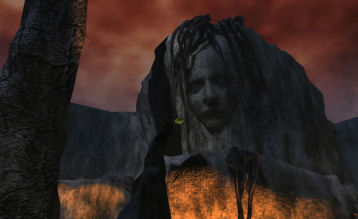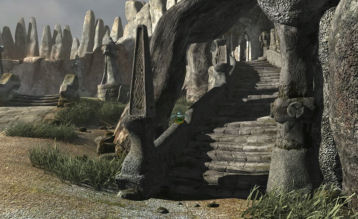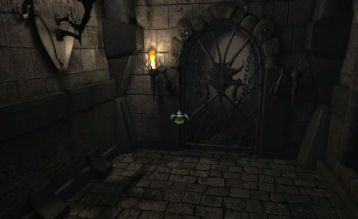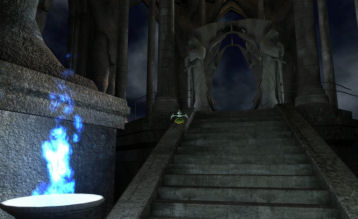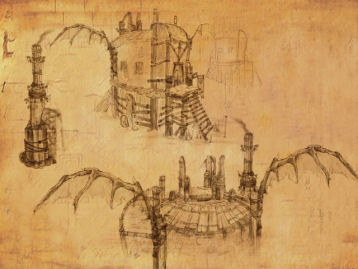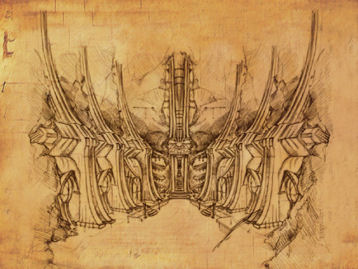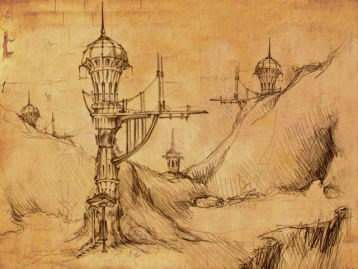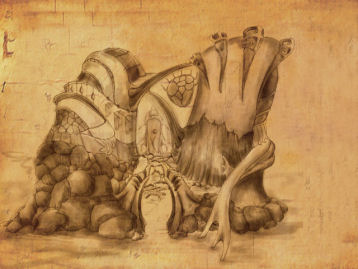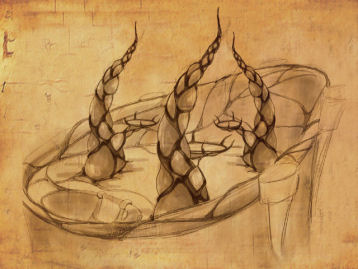|
Aura 2: The Sacred Rings Developer Diary #6 by Evgeniy Lebed of Streko-Graphics The choice of ‘Virtools’ for the game engine of Aura 2: The Sacred Rings was primarily made for the following reasons: to make more difficult and interesting puzzles (mostly the combinatorial type); to make the gameplay atmosphere more dynamic (rain, water drops on puddles, dynamic sky, fog, other particles); to achieve better stability when the game is running on different Windows® platforms (the game works on all Windows® systems ranging from Win98SE2® to Windows Vista™, and with video cards 64 MB or higher). Our main difficulty was incorporating a massive amount of video cut-scenes and other animations into the game itself. At the start of the project we were using ‘Virtools 3.0’ which did not support all of the formats that we were using, not to mention the massive amount of animations that we had. The main format that we were using for all of our video animations was Bink. The start of the project (from my point of view, anyways) could be described as debugging and polishing the plugin that we used to regenerate and reproduce the different video formats.
The integrated technology allowed us to realize that all of our issues were, in one way or another, related to the videos in the game. Unfortunately, we were not able to integrate the built-in Sound Pipe in Bink to the Sound Module in Virtools. We decided to use Bink technology to reproduce the side pipes of the videos. A large portion of our time was spent making logical connections between all the different aspects within the game.
‘Standard Virtools Blocks’ were used as the main language for logical connections. At first this caused a large number of problems resulting from having to reorder many components in almost all the scenes. However, Virtools was an outstanding tool for fast prototyping and for the testing of all the puzzle elements. It is worth mentioning that the game contains 75 different puzzle elements which were all written using the Virtools Blocks, most of which are puzzles themselves. There are 454 scenes in which these puzzles are scattered around. The scripting language, ‘LuaScript’, was the other language that we used for assembly of all the different locations. It is used to describe the relative geometry of all the scenes, sounds, logical cells, sprites and loading of textures. The entire game engine of Aura 2 is built on the concept of managers, each of which is responsible for one aspect of the game – puzzles and menu, inventory and notebook, loading and saving, etc. In general, the game engine is based on Virtools and resembles the engine of Aura: Fate of the Ages in one form or another.
Developer Diary #4 by Evgeniy Lebed of Streko-Graphics Since the entire development team of Streko-Graphics is currently busy trying to meet the deadlines set out by our publisher, The Adventure Company, I was once again chosen to do the Developer Diary. In this Diary I will describe where the development of the game currently stands. Up to this point we have completed the design and the implementation of all the locations in Aura 2: The Sacred Rings. This includes all modeling and texturing. We can now walk around and look at the beautiful environments and we have also arrived at the fun part – designing the final look and location and implementing the game’s puzzles. This is a fun process because this is where we finally get to see the game “come to life.” Our animators are currently continuing their work on the eye-candy of the game: the cut-scenes. You can expect the cut-scenes to be longer and more involved. The animators have a much bigger job to do this time, as we want to make the cut-scenes more dynamic than in the original game. These videos are going to be a lot more life-like and realistic. You will be able to see this in our teaser trailer (which we will release very soon). As for the audio, we are planning to use approximately eight different musical compositions. To write these musical compositions, we have invited the talented Nicholas May to help us. We plan to have him talk about his work in an upcoming Developer Diary. I would also like to mention something about the special effects that we are going to implement. As opposed to Aura 1, the worlds in this game are going to be more dynamic and realistic. For example, we are going to have rain, moving clouds and even changing times – day and night. Of course, other dynamic objects and properties are going to be put in the backgrounds. You will have the feeling that you are in a real, dynamical environment! It won’t be long before we are finished, and you will be able to enjoy what we have been enjoying for months.
Developer Diary #1 by Evgeniy Lebed of Streko-Graphics I thought that I would write about the rather peculiar topic of “What came first, the story board or the game design?” Since The Sacred Rings is an adventure game, you might say to yourself, “Of course the storyboard came first!”, but I hate to disappoint you. It’s not as simple as that. Let me explain; Aura: Fate of the Ages was the first major project that we attempted. We weren’t even sure if we would be able to create anything that resembled a semi-decent game. We knew that we wanted to create “a game” but we didn’t even know what type or style of adventure game it should be. Because of this, we played around with a lot of different technologies; trying to figure out what we could and wanted to do. After experimenting with different interfaces, we decided that the point-and-click interface was the simplest interface to work with. So now we had our interface. Great! What’s next? We thought that we would try it out by building a small example of the classic puzzle game “16” (you know, the one where you have a 4 by 4 board with 15 numbered squares on it, and you can slide each one of the squares to arrange the numbers in order.) This worked great. So then we started to build new, unique puzzles, of course some much harder than the others. Once we had a pretty large collection of puzzles we thought that it was about time to start putting them together into a game. By this time a lot of the game elements were already completed; the puzzles, a large collection of character models, some environment scenes. Only at this point did we start thinking about the story of the game. I must say that this was a very challenging task – to take selected characters from an already existing library (that we just created) and think up some sort of a meaningful story. The Sacred Rings has been much different. After finishing Aura: Fate of the Ages, we knew that we could work with the technology, we knew that we could make good character models, and we knew that we could make good animations. Nearly all of the most important elements of a good game were there. So we thought that this time we would concentrate on the story first, and only after we had the story, we would start the rest of the game design process.
copyright © 2006 GameBoomers |
||||||||||||||||||||||||||||||||


